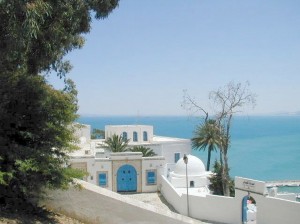OUTDOOR
Nature
Tunisia unites various geographical, climatic and cultural characteristics that make it ideal for lovers of areas where the sea, mountains and forests overlap.
Tunisia’s dazzling sites and its landscape are combined in a small area which comprises the mysterious enchantment of the Saharan oases of Tozeur, Nefta and Douz, the snowy loneliness of the forests at Ain Draham, the excitement of the beaches of Hammamet or Sousse, the Polynesian magic of the Island of Djerba and the secret attractions of Sidi-Bou-Said, which is lost in time on its rock overlooking one of the most beautiful gulfs in the world.
Coastal Tunisia
With 750 miles of coastline, mostly unexploited, beaches of fine sand, the softness of the Mediterranean climate, shimmering sun and blue water, the Sahara Desert in the South and region of mountains, hills and green plains in the North,Tunisia offers beautiful and contrasted natural landscapes. From the Coast of the Coral in Tabarka and Bizerte; the Coasts of Carthage close to Tunis; the Hammamet resort; the port of El Kantaoui near Sousse, the Monastir and Mahdia resorts to the Djerba island, sightseeing nature in Tunisia fills visitors with wonders.
Natural Sites to visit
Often known as ‘Green Tunisia’, the Tabarka/Ain Draham coral coast region is a delightful part of the country, a region of hills, mountains and fertile plains. Temperature variations can be great, and occasional snow covers the peaks of Khroumiria. The weather is cooler in the summer season than in the south. The wooded and flower-decked foothills of Khroumiria, behind The Coral Coast, have more than a hint of unspoiled Provence, although the forests are of cork trees rather than olive. Deer, lynx, civets and jackals may be glimpsed by naturalists throughout the year. The region of Ain Draham has 80 000 hectares of cork oak, pink bay-trees, and thousands of plants as well as a horse center. This large variety of landscapes and sites where, between the trees, one can enjoy the superb blue sea of the Mediterranean, fresh air and old Roman cities nearby is an amazingly rewarding experience. Between sea and forest, Tabarka is well know for its corals, its rock coast quickly making place to beautiful white sand beaches and prestigious hotels, its fishing port, its marina and its golf. It is also a true paradise for diving, fishing, sailing and hiking.
The Cap Bon region is known as the “garden of Tunisia”. The jasmine and orange blossom scented air has an enviable sweetness. Cap Bon has a maritime climate (mild throughout the year), varied landscapes and an easily accessible coast, a combination of features which made this a popular holiday region amongst the Punic and Roman aristocrats. Jutting out between the Gulf of Tunis and the Gulf of Hammamet, Cap Bon encompasses important wine-growing areas and produces fine figs, olives, oranges, lemons and cereals.
The town of Sousse, was previously known as Hadrumete and was built by the Phoenicians in the 9th Century BC. A town which was Punic, Roman and then Muslim, Sousse has retained a great deal of character. Sousse is surrounded by very find crenellated ramparts, dominated on one side by the imposing Kasbah and on the other by the mosque and elegant Ribat. The medina houses souks which are the most typical in Tunisia. Many high-class hotels stand along the beautiful fine sand beach which stretches for several kilometers. Nearby is El Kantaoui, one of the Mediterranean’s main garden ports, with the seductive charm of its houses built in the purest tradition of Moorish architecture.
Legendary home of the “lotus eaters” and Ulysses himself, the sun-drenched island of Djerba has mile upon mile of unspoiled beaches lightened by the clear blue waters of the southern Mediterranean. As Djerba is virtually flat with little traffic, a bicycle is a great way to explore, or for the less energetic, a motorbike. Local buses and taxis are cheap and readily available too. Djerba is linked to the mainland by a causeway or ferries which run half-hourly.
Golf & Water Activities
Tunisia is rapidly gaining a reputation for being one of the Mediterranean’s foremost golfing destinations.
Until the end of the seventies, only one golf course, that of Carthage/Soukra created in 1927, existed in Tunisia.
In less than ten years, seven golf courses stretching the entire length of the Mediterranean coast were built, designed by Masters of great talent such as Ronald Fream or Martin Hawtree.
The Soukra golf course was completely restored.
Four other projects of golf are in the course of realization including one in the Sahara (PromoTunisia is currently overseeing the accomplishment of a 27 hole course in the Sahara desert).
The golfs operate all year long. Although very diverse, they all have one thing in common: they were established on premium sites, whether it is near the sea, the mountain or the desert, they all offer very beautiful panoramas.
Tunisia has eight main courses:
The Tabarka golf course is situated on a 270 acre eucalyptus, pine and oak forest overhanging the ocean on the edge of the coral coast.
The Carthage golf course demands skill and accuracy as players negotiate among hundred-year-old eucalyptus trees.
Hammamet is home to two courses:
The Yasmine golf course gives players a chance to enjoy both the Mediterranean and the surrounding hills.
The Citrus golf course is designed around six lakes and 300 acres of olive groves.
The El Kantaoui golf course in Sousse dominates the famous holiday resort of the same name and is host to numerous international competitions.
The Monastir golf course is set on a garden plateau suspended between lakes and the sea.
The Palm links golf course is also situated in Monastir and close to one of Tunisia’s best beaches.
The Djerba golf course on the island off the coast of the mainland is one of the country’s most impressive. The 27 hole course has golfers winding their way through palm trees and climbing sand dunes to reach the sea.
Tunisia guarantees a golf holiday where everything is just a little different. The sunsets, the exotic sights, the atmosphere, the local color … golf can be an adventure in itself, but Tunisia guarantees that your adventures will continue when you take off your golf shoes …
Thalasso, walking & hiking
Thalasso
Thalassotherapy is the utilization ofseawater at a given temperature,algues and marine muds with apreventive and curative aim.
Tunisia is the ideal place for thalasso services with its luxurious hotels,climate softness, sunny weather, 750 miles coastline and para-medical competency.
Installations are found in top hotels and are equipped with sophisticated top of the line equipments. The hotels propose a la carte services. The Tunisian government imposed very rigorous standards in terms of equipments and requires the presence of a doctor, medical staff and chiropractors.
Treatments include heavy legs, anti-tobacco treatment, slimming, anti-rhumatism, young mothersand beauty care .
It attracts more generally anybody who need rest and wellness care.
Following the tradition of Punic bathtubs, roman thermes, Arabic hammam, Tunisia ranks second in the world for the quality of its treatments and the professionalism of its thalasso staff
Walking & hiking
Walking and Hiking in the Tunisian hinterland is worth a detour. On foot, you can set off and explore Djerba’s rural tracks or the shady, winding roads around Tabarka, in the area around the mountains of the North West to give you a foretaste of the little-known scenery that is made for ramblers.
For example, the vast verdant landscape of forest in Ain Draham, the red-roofed town, which is perfect for long walks, and the steep mountains of the west, for trekking.










